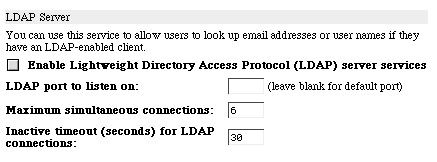|
LDAP
Lightweight
Directory Access Protocol
Introduction
to LDAP
The
LDAP Service Control Panel
LDAP
Client Settings
LDAP
Server Settings
Troubleshooting
Resources
| Note:
Feb 8, 2000: The LDAP interface in the Control Panel has been
removed temporarily to prevent confusion pending upgrades
to Web Crossing LDAP service. |
Introduction
to LDAP
Lightweight
Directory Access Protocol (LDAP) provides outside clients access
to Web Crossing user directory information, such as usernames
and email addresses.
WebCrossing
can act as both an LDAP server and a client. Using these features,
Web Crossing can provide directory information to standard LDAP
search services and also allow authentication of users between
two cooperating Web Crossing sites.
In many
cases, you might find your needs for LDAP are better served by
Web Crossing's support for the newer XML-RPC
functionality, which supports remote procedure calls.
The
LDAP Service Control Panel
You
turn on LDAP in the Control
Panel > LDAP
service panel.
This
control panel is divided into two sections: one section allows
you to set up Web Crossing as an LDAP client, so that it accesses
an LDAP server to retrieve information. The second section lets
you set up Web Crossing as an LDAP server, providing information
to incoming clients.
LDAP Client Settings
Figure
1 - LDAP Client Settings

The
LDAP Client settings in figure 1 are as follows:
- The
Enable Lightweight Directory Access Protocol client service
checkbox is the on/off switch that enables and disables Web
Crossing LDAP client services.
- The
LDAP Remote Server Address is the address of a known
LDAP server, which may be another Web Crossing server. You will
need to turn on Web Crossing LDAP server services in the remote
Web Crossing server.
- The
LDAP server port is the TCP/IP port used for making LDAP
connections. The default
port number
is 389.
- The
LDAP server password is used if a password is required
for accessing the remote server.
- The
LDAP Server DN is the distinguished name for the remote
LDAP server. LDAP directory entries are part of a hierarchical
names space, analogous to the DNS name space described in the
Internet
Concepts
section. The entry here is a path to the data entry you want
Web Crossing to find. In other words, the DN you provide gives
Web Crossing a starting place from which to search.
LDAP Server Settings
Figure
2 - LDAP Server Settings

The
LDAP Server Settings shown in figure 2 are as follows:
- The
Enable checkbox turns on an off LDAP serving for your
Web Crossing server.
- The
LDAP port to listen on is the TCP/IP port for LDAP services.
The default
port number
is 389.
- The
Maximum simultaneous connections value lets you limit
the number of TCP/IP connections served by LDAP. This allows
you to control load balancing for your system. If you have limited
bandwidth, you might want to keep this number low to prevent
excess LDAP requests from overwhelming your system.
- The
Inactive timeout setting value is the time at which Web
Crossing will sever an LDAP serving connection if there is no
response from the requesting side.
Troubleshooting
Lundeen
& Associates are in the process of upgrading their implementation
of LDAP. If you are experiencing difficulties, please keep in
touch with new release information posted on the Web
Crossing site's forum.
Resources
Sysop
Control Panel
Web
Sites
|

